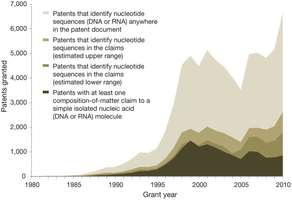Study assesses impact of pending landmark US Supreme Court case on gene patents

(Phys.org) —As the U.S. Supreme Court moves closer to a decision this summer in the landmark gene patent case against Myriad Genetics, a study, led by Colorado State University, is shedding light on what may be at stake.
Gregory Graff, associate professor of Agricultural and Resource Economics at CSU, and a team of researchers at University of Minnesota and Pennsylvania State University analyzed U.S. patents to find that the case may not have the dramatic impact that some in the biotechnology industry fear it will. However, they caution, the Supreme Court's decision may have unanticipated impacts on patents that claim sequences from species other than just humans.
Graff's paper ,"Not Quite a Myriad of Gene Patents: Assessing the potential impact of the U.S. Supreme Court on the changing landscape of U.S. patents that claim nucleic acids," will be published in Nature Biotechnology this month.
The plaintiffs in the Myriad Genetics case are seeking resolution as to whether of not an isolated DNA molecule with a natural genetic sequence from the human genome should be considered eligible to be patented. According to recent commentary, there is good reason to expect the Supreme Court may decide to ban gene patents.
As the case was winding its way up through the courts, Graff and his team of collaborators began a comprehensive, in-depth review of how many and what sorts of U.S. patents make the kind of claims to DNA that were being challenged in the Myriad Genetics case.
The study analyzes the different types of claims that constitute a "gene patent" and then determines the number and nature of U.S. patents that could be invalidated by a Supreme Court ban.
"Our intention was to give some sort of measure to the potential legal and commercial implications of what is squaring up to become a landmark patent case, one of the most significant Supreme Court cases in the biological sciences for decades," said Graff.
This is the first study of several to draw upon a new and massive worldwide compilation of patents related to genetics and genomics, put together by Graff and collaborators at the International Science and Technology Practice and Policy (InSTePP) Center at the University of Minnesota over the past three years with funding from the National Institutes of Health (NIH).
What distinguishes the study from previous research is the way in which patents were counted and "read" by computer algorithms. Graff worked with other collaborators at Pennsylvania State University to train computer programs to pick out just those patents with precisely the same kind of legal language being challenged in the case. The research also goes beyond just considering human genes to analyze genes patented from all types of organisms, leading the study to raise questions about the full implications of the case.
Fewer than previously thought
The results of the study show that there are fewer U.S. "gene" patents – particularly the kinds that are being challenged in the Myriad case – than prior analysis have suggested. According to Graff, "We caution that some of the hype and drama surrounding this case may be unwarranted and that, if overturned, the impact is unlikely to be devastating to the interests of the biotechnology industry."
The study also shows that, despite the focus on the patenting of human genes for use in medical diagnostics, the majority of gene patents actually claim genes from other organisms, ranging from mice to corn to microbes.
"This finding poses a serious question that the U.S. Supreme Court will need to resolve because the Myriad case is, supposedly, only looking at whether human genes are patentable," said Graff. "According to our results, there appears to be no simple way, given the logic of genetics or of patent law, to make a clean distinction between the small number of patents that claim human sequences and the larger number of patents that claim sequences from other species."
The third key finding is that for the past decade, applicants appear to have been moving away from making the kinds of patent claims that are at greatest legal risk in the Myriad case. The researchers suggest that other policy measures and lower-court decisions in other cases may have already been effective in nudging patent practice away from those types of gene patents that the plaintiffs in the Myriad case and the American public find most objectionable.
The full paper, "Not Quite a Myriad of Gene Patents: Assessing the potential impact of the U.S. Supreme Court on the changing landscape of U.S. patents that claim nucleic acids" can be viewed at www.nature.com/nbt/journal/v31 … 5/full/nbt.2568.html .
Journal information: Nature Biotechnology
Provided by Colorado State University


















